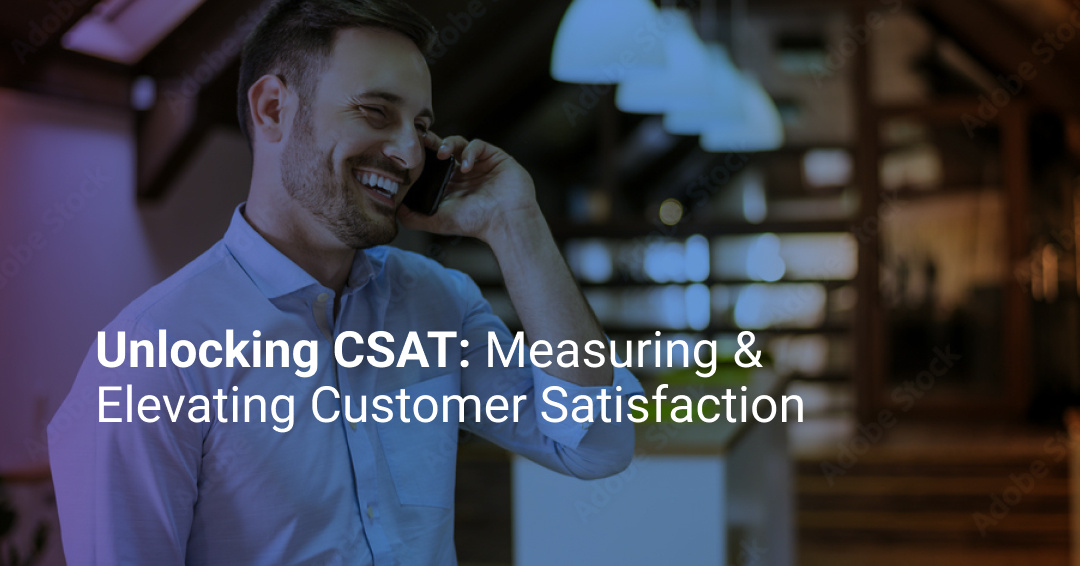12 Call Center Metrics You Should Be Using to Improve CX in 2025
Call center metrics are the most important performance indicators that monitor how effectively your call center is running. This includes anything...
8 min read
![]() Mosaicx
:
August 02, 2024
Mosaicx
:
August 02, 2024
Not many people want to contact customer service. Usually, that means something went wrong, and it makes things worse when a customer doesn’t get what they expect. To avoid this problem, many companies are rethinking the business-consumer relationship to focus on another concept: customer experience.
Firms that lead in customer experience report 5-10% higher revenues and 15–25% lower costs. Long hold times, constant transfers, and having to repeat oneself are just a few factors that impact satisfaction. In this blog, we’ll define the differences between customer service vs. customer experience and offer ways you can offer better experiences for your customers.
There are multiple definitions of customer experience but what matters is that they all converge on a single principle: making sure customers perceive your company positively. This is the result of accurately understanding the touchpoints customers go through with your product all the way from pre-purchase to post-purchase. It also takes into account the ways in which customers get to find your product, from the moment of awareness and discovery all the way through retention and recommendation.
Customer service refers to the actions brands take to support customers when they have a question or face a roadblock. To build a great customer service process, it is important to consider support channels, the types of service you need to provide, some of the key functions that are helpful to customers, and, of course, basic service skills like listening, empathizing, solving problems and having patience.
People often view customer service and customer experience as synonymous, but they’re not the same.
Gartner defines customer service as "retaining and extending customer relationships once a product or service is sold." It’s about making sure a customer is satisfied with a single transaction, usually facilitated in a contact center.
To define customer experience, Gartner says it is "the sum of all the interactions a customer has with a company” and "the customer's perceptions and related feelings caused by the one-off and cumulative effect of interactions with a supplier's employees, systems, channels or products."
Customer experience covers the whole customer journey. This includes customer service, but that’s not all. Customer experience consists of all interactions a consumer has with the company through the contact center, in-store, marketing materials, and even while using your product or service.
Let’s explore some of the key differences between customer experience and customer service in more detail.
Customer service is concerned with a single objective: providing excellent service. Customer experience, on the other hand, is a much larger endeavor that includes service, perceptions, marketing touchpoints, etc. Think of customer service as the department that ensures customers are satisfied with the product or service and customer experience as the one that refers to the overall brand perception.
Customer service generally plays an important role when customers have problems. People working in this field must ensure that issues get solved quickly to prevent churn. CX is a bit more proactive and tries to focus on building experiences that are so positive and helpful that problems don’t even take place.
Customer service generally focuses on providing excellent service based on the customer channel and single point in time being used. In other words, if they call you with a concern, the objective is to ensure it gets solved fast during that particular call. In opposition, CX does not focus on solving problems in a single channel but on creating an integrated and interactive experience across all channels for customers.
There are three main metrics used for customer service departments: customer satisfaction score (CSAT), customer effort score (CES), and Net Promoter Score (NPS). While some of them also overlap with CX, generally speaking, when you work in a CX department, you are more concerned with metrics such as customer lifetime value (CLV), churn rates, retention rates, etc., that inform the overall experience of a customer not just how easily they can solve a problem.
Customer service is the responsibility of the customer support teams. They're the ones who talk to customers, solve their problems, and ensure quality of service. CX is not a particular department's responsibility but a compounding perception of any specific brand. In other words, everything around the brand, including how its employees interact with it, is part of that perception.
Instead of focusing on customer service or customer experience, organizations should understand that excellent service is part of the customer experience process. In other words, brands should focus on creating a great overall experience for the customer. This process includes the service they receive, marketing efforts, the way sales reach out to offer new products, and any other proactive efforts.
For many businesses, the contact center is the primary provider of customer service; therefore, contact centers play a bigger role in adding value to the customer experience.
Let’s break this down. The defining characteristics of great customer service and experiences develop over time. With digital transformation on the rise, "innovation" and "adaptability" are at the forefront.
The channels we use also evolve, with experts claiming that digital channel adoption fast-forwarded seven years during the first eight weeks of the pandemic. This shift forced companies to accelerate their strategies and turn transformation plans into adoption seemingly overnight as a way to meet new customer service expectations.
Before, businesses viewed contact centers as a platform to provide customer service. Now, with the focus on customer experience and minimizing the impact of pandemic-related disruptions, companies are enhancing their customer service contact centers to support the needs of individuals and businesses operating from home.
Consumers have learned from experience that contacting support can be time-consuming. Therefore, reducing the effort required by customers to access support increases the likelihood that a customer will be loyal. Consequently, failing to provide a positive experience can easily fuel disloyalty. Contact center solutions can better meet customer needs if they are easy to navigate, quick, offer complete answers, and feel in control.
To better understand the differences between customer service and customer experience, it is beneficial to look at examples of excellent customer service and customer experiences. "Great" customer service accounts for the little details: unique gestures such as gifts, frequent thank you's, the anticipation of customer needs, or involvement in social causes. Customer service truly stands out when businesses include a level of personability that makes customers feel valued and more than just a number.
For example, a customer flying JetBlue once tweeted that he was upset he hadn't been able to get his coffee before boarding. Within seconds of sending the tweet, JetBlue contacted its customer service team at Boston's Logan airport. The customer service team promptly delivered a mocha to the customer, all before takeoff, which resulted in the customer raving on Twitter, promoting the airline in a way that otherwise may not have been possible. JetBlue saw the opportunity to go above and beyond and deliver high-quality service to the customer.
In this example, JetBlue tailored its customer service to satisfy one customer. The team prioritized a single transaction, which boosted the airline's overall reputation.
To better understand customer experience, consider Zalando’s 100-day return policy. This policy limits long return lines after holidays and eases anxiety to return products immediately. Another example is Starbucks’ loyalty program, which uses gamification to make earning points fun. Plus, the Starbucks app remembers your order, as do many Starbucks baristas. These policies are designed to impact every customer touchpoint, from online shopping to in-store purchases to returns and beyond.
Are there any key performance indicators (KPIs) that track customer service? The measurement of customer service and customer experience KPIs share many similarities, including customer surveys and contact center metrics like call abandonment rate, the average speed of answer, and first-call resolution.
These metrics are used as customer service KPIs to track how a customer feels about one interaction with the brand. As customer experience KPIs, they track data across the entire customer lifecycle. Below are several more customer experience KPIs to measure.
Customer satisfaction (CSAT) is a core metric companies use to measure customer experience. Companies typically gauge satisfaction following an interaction with a support representative or after a customer uses a product. The KPI is based on the customer's perception of the quality of service.
Many companies use surveys to track CSAT. The survey includes one or more variations of the question, "How would you rate your overall satisfaction with the [goods/service] you received?"
Respondents use the following 1 to 5 scale to answer the question:
The business then averages the survey results to get a composite CSAT score, which is typically a percentage.
Net Promoter Score (NPS) is another standard indicator companies use to measure their customers’ propensity to recommend the brand. NPS is calculated from the question, “Would you recommend this company to a friend/colleague/relative?”
Based on the response, customers are put into one of three categories according to their degree of enthusiasm:
The final score is then calculated by subtracting the percentage of detractors from the percentage of the promoters. Brands can easily compare their NPS score to their direct competitors and market leaders.
Another measure of customer experience is the Customer Effort Score (CES). This is the third most prevalent method of calculation that involves customer input. CES uses a 5-to-7-point scale system and asks, "How easy was it to solve your problem today?"
CES is a transactional metric that helps businesses analyze a single customer interaction's complexity or simplicity. This makes it a customer service KPI, foremost, but a valuable measure improving customer service improves one aspect of customer experience.
Retention rate is another KPI that indicates how well a business can maintain its customer base over a period of time. Churn rate is closely related to retention, as churn reflects the number of customers who have ended their use of a business's services or products over a particular period. The goal is to have as low a churn rate and as high of a retention rate as possible.
As the name suggests, customer lifetime value (CLV) is a KPI that measures a customer's entire relationship with a company. Since it is less expensive to keep an existing customer rather than recruit a new one, CLV is important, as it informs businesses on how they can increase the value of existing customers. CLV is typically seen as an average. Companies can calculate it over a specific period, or over the entirety of a business and consumer relationship.
First Response Time (FRT), Average Resolution Time (ART), and Average Wait Time are important ways to measure customer service effectiveness. FRT measures initial response speed after a customer reaches out, which usually leads to higher customer satisfaction. The faster you solve your customer's problems, the happier they will be with your service.
ART tracks how long it takes your team to resolve an issue from the first contact to the final solution. A lower ART means teams have the skills and capacity to do great work and solve problems.
Finally, the Average Wait Time metric revolves around customers waiting time before service is provided. As a general rule, decreasing the response time improves customer experience, given that users are given a quick answer that leads to a less stressful interaction.
When it comes to contact center solutions, there are technologies that companies can use to solve the issues mentioned previously, such as long hold times, repetitive communications, and slow response times.
In addition to conducting surveys to assess customer needs and implement changes, companies can boost customer service with AI-powered technology. More and more customer service and support teams are using AI to facilitate day-to-day operations. In fact, 55% of established companies have already started investing in AI technology. Moreover, AI bolsters a company’s ability to develop creative and strategic initiatives and manage the customer experience in a proactive way.
AI-powered contact center solutions and personalization of customer service boost the effort to increase satisfaction by speeding up the service process and collecting data on customers to better understand and serve their needs.
AI features like skill-based routing remove the inconvenience of transferring between multiple reps. Instead, the customer reaches the right person the first time. Personalization of service and quick answers come into play as contact center AI can direct inquiring customers to a strong knowledge base filled with answers pulled from a history of others with the same issue or query.
AI-powered support chats and AI-assisted support agents like our conversational AI tool, Mosaicx, can solve customer requests in much less time than human agents alone. AI-enabled agents create contextual and personalized interactions without help from a human agent. Companies can automate common customer inquiries, minimize wait times, establish easy AI-to-agent handoff, lower average call costs and increase customer retention. As a result, companies will improve the customer experience and see greater customer loyalty and satisfaction.
Understanding the differences between customer service and customer experience is the key to increasing business success. Businesses can maintain this success by analyzing customer experience KPIs, listening to customer feedback, and incorporating new technologies that meet modern customer needs.
In today’s climate, it is essential that companies prioritize the customer experience. AI-enabled contact center solutions can help boost the customer experience. By empathizing with customers and providing what they need, companies ensure a healthy relationship with customers that will benefit both parties in the long term.

Call center metrics are the most important performance indicators that monitor how effectively your call center is running. This includes anything...

Businesses across industries have changed or evolved over the decades, but one thing that has remained the same is that their growth is pretty much...

Customers have several major expectations from modern businesses, but none is as challenging as them reading your mind to anticipate support you...